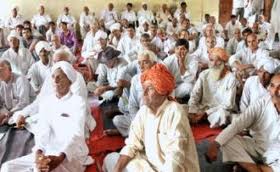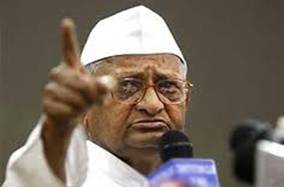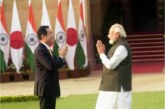Dr Arvind Kumar, President, India Water Foundation, New Delhi.
The anti-corruption campaign launched by Team Anna Hazare in recent months has brought into focus hot debate on civil society vs. government vs. the people in India. This campaign is seen as a crusade against corruption and Team Anna insist on the enactment of a comprehensive Lokpal Bill. Baba Ramdev, a yoga guru, is agitating for curbing black money. Both Anna Hazare and Baba Ramdev claim to speak for ‘civil society.’ Initially, the government responded enthusiastically by extending them VVIP treatment and Group of Ministers (GoM) holding consultations with them.
Suddenly something went wrong and the government dragged its feet and refused to talk to ‘civil society’. Home Minister P Chidambaram said “Elected members cannot yield to civil society” since this might undermine “parliamentary democracy.” This brings into focus a tripartite debate – civil society vs. government vs. the people.
Broadly speaking, the term civil society was originally coined to describe popular movements in Latin America that sought to counterbalance the power of oppressive governments on the one hand and exploitative international financial interests on the other.1 However, over the years it has expanded to encompass a variety of non-state actors, including formal organizations, informal networks and social movements. In the post-Cold War period, non-governmental organizations (NGOs) have flourished and are increasingly acknowledged as critical actors in the contemporary society.
According to the Centre for Civil Society at the London School of Economics, “civil society refers to the arena of uncoerced collective action around shared interests, purposes and values. In theory, its institutional forms are distinct from those of the state, family and market, though in practice, the boundaries between state, civil society, family and market are often complex, blurred and negotiated. Civil society commonly embraces a diversity of spaces, actors and institutional forms, varying in their degree of formality, autonomy and power. Civil societies are often populated by organizations such as registered charities, development non-governmental organizations; community groups women’s organizations, faith-based organizations, professional associations, trades unions, self-help groups, social movements, business associations, coalitions and advocacy groups.”2
Civil society is contrasted by some experts with the state (government and parliament) and formal political sector (e.g. political parties) as an alternative means of directly representing the will of ordinary citizens that organize in private entities but are active in the public arena. Civil society entities are an important moderating force in society, providing a middle ground between identification through either the state or tribal, familial or ethnic ties.3
Civil Society and NGOs
Civil society and Non-Governmental Organizations (NGOs) are sometimes construed in identical terms. However viewed in broader perspective, NGOs are a subset of civil society and represent a growing sector. There has been a mushroom growth of the NGOs in almost all countries, including India. They have become increasingly significant actors in international development. NGOs engage in a wide array of activities, including undertaking research, implementing projects, advocating and raising public and political awareness about numerous issues. Many NGOs perform all of these activities, using research to develop programs and support advocacy.
According to the Commonwealth Foundation, NGOs are characterized by four key features, which inter alia include:
- Formed voluntarily by citizens– there is an element of voluntary participation in the organization, including voluntary staff or board members.
- Independent– NGOs operate within the laws of the state, but they are controlled by their founders and elected or appointed board. The legal status of NGOs is based on the freedom of association – a basic human right. The 1966 International Covenant of Civil and Political Rights, ratified by 152 countries (June 2004), grants the right to assemble (see section below on NGO laws).5
- Not-for-profit– NGOs are not for private gain or profit. They can generate revenues, but only to further their mission. NGO employees can be paid for their work. Board members are typically not paid, but do get reimbursed for their expenses.
- Not self-serving in aims or values– the aims of an NGO must be to improve the prospects and circumstances of people and to address issues detrimental to society at large or to particular sectors.
Ideally, NGOs contribute to civil society by promoting pluralism and diversity, advancing arts and science, promoting culture, motivating citizens to engage in civic life, providing services and creating an alternative space from the state for reflection on key social, political and economic issues.
In recent years, the Bank has increased its collaboration with NGOs, working directly with national organizations or Community-based organizations (CBOs), rather than with international entities.
The NGOs, by virtue of their activities, are often under constant threat of closure and having their staff arrested. These difficulties emanate from the fact that legislation governing NGOs and their relationship with the state, in some cases, is non-existent or weak.
There exists a vide variety of NGOs which are engaged in vast array of activities in India. Most of the NGOs are engaged in project works and many are just for name’s sake. Some of them are patronized by business houses. There are very few NGOs in India which can claim to serve the national/public interest.
So, the NGOs should not be confused with civil society. Civil society is a comprehensive term and NGOs are a subset within a civil society.
Civil Society in India
 The institution of civil society is not alien to India. The roots of an Indian autonomous civil society date back to the ancient and medieval periods. Cast “panchayats”, village “panchayats”, or trader’s guilds all illustrates forms of local institutions that had long been untouched by the vicissitudes of the political spheres and remained autonomous from state control. Indian society had been characterized in pre-colonial times by a form of “insularity” that thus ensured a certain independence from state power but also resulted in stagnation and an impossible unity of the population.
The institution of civil society is not alien to India. The roots of an Indian autonomous civil society date back to the ancient and medieval periods. Cast “panchayats”, village “panchayats”, or trader’s guilds all illustrates forms of local institutions that had long been untouched by the vicissitudes of the political spheres and remained autonomous from state control. Indian society had been characterized in pre-colonial times by a form of “insularity” that thus ensured a certain independence from state power but also resulted in stagnation and an impossible unity of the population.
However, the modern definition of an Indian civil society has to confront the radical transformation of the State and its consequences on the role of the non-state actors. The transition to independence was accompanied with the rise of a welfare state, extending state powers into areas that had been previously left to civil society. This “intrusion” of the State and its monopoly on new spheres as education, health or security resulted in a form of state monopoly in almost all public goods, giving to the state the role of first employer of organized workers in the country.
The generalization of taxes, the ownership of public utilities transformed the state into an arbiter between individuals. But this rise of a welfare state pointed out in the same time its dysfunctions and its failures.
Corruption and nepotism put into question the legitimacy of the state power. Distribution of licenses, subsidies for the poor, control of the crime order are said to be “the plaything of state functionaries” that have lifetime security. The situation of political parties is also perverted by a form of selection of its members by the leaders that constitute an obstacle for the participations of the citizens to the political process. The electoral process itself is put into question by the irregularities of the polls but also by the biased aspect of local elections that are mostly determined by cast belongings and the money involved in the campaign.7
The period from 1977 onwards witnessed an increase of activities within traditional social movements such as peasants, workers and students, but also amongst the so called “new social movements”, including environmental groups and women’s organisations.8 Mobilizing new political identities, these groups challenged the state on local, regional and national level, as these NGOs were often based in strong grass root networks.
State ‘developmentalism’ as a project was questioned, and from the 1980s and onward also the Indian state itself have encouraged NGOs to take more responsibility for social development. The numbers of NGOs in India also started growing all the time.9
A general international trend towards more of individual and private initiatives and less of government planning was of course also behind this expansion. The neo-liberal reforms of the IMF and the World Bank which have had such drastic global consequences in the Third World have affected also India where the partial withdrawal of the state has resulted in a more active civil society. Due to their preference to work with NGOs, the presence of international aid organizations have contributed further to this development.
Apparently, the partial failure of the state to address social and economic needs has had effects on the levels of development, but also on the quality and character of civil society. In some sense this failure has spurred groups and individuals to engage in civil society, but the inability to provide basic education and other forms of social services has seriously hampered the development of civil society, with low levels of literacy being a case in point. As a consequence the Indian state, and various aid agencies, has utilized the competence and infrastructure of civil society in order to encourage social development.
According to one opinion, owing to the inherent social, religious, ethnic and economic cleavages of Indian society, the civil society is permeated by inequality and various forms of conflict, as noted in the current Indian debate.10
Conclusions
The relative failure of the Indian state created feelings of exclusion amongst large segments of the population, and allegations that the state is not neutral, but biased on the basis of class and caste interests. These alleged biases have in turn created sentiments of apathy and also facilitated negative mobilization and manipulation of various primordial identities such as ethnicity, religion and caste. This segmentation of Indian society has had ambiguous consequences and has led to demands and actions which have seriously undermined the democratic system by the strengthening of exclusivist identities. These are based on religion, caste or ethnicity and are now at the centre of political mobilization, which involves political parties as well as other parts of Indian civil society.
The claims of Anna Hazare group as well as Baba Ramdev group as representatives of the civil society has necessitated the need for redefining the civil society and develop legal framework for legitimate civil society. According to one opinion, both are self-selected groups claiming primacy over the elected government. Both asserted they knew what was best for the nation. (Rather than an electorate they scorned as sold on a bottle of liquor or a hundred-rupee note).11
There is dire need for a debate on the role of civil society vis-à-vis government and the political parties. Civil society is construed in terms of a link between the people and the government and it should not be allowed to be hijacked by vested interests to grind their axe. In actual practice, where government fails or political parties miss the opportunity, the civil society should fill the space to come up to the expectations of the people, especially the marginalized and deprived segments of the society.
Notes
- For details see Jude Howell and Jenny Pierce, Civil society and development: a critical exploration, Boulder, CO: Lynne Reinner, 2001.
- The London School of Economics and Political Science, What is Civil Society?, 1 March 2004, available at http://www.lse.ac.uk/collections/CCS/what_is_civil_society.htm.
- Sanam Naraghi Anderlini and Judy El-Bushra, Justice, Governance and Civil Society, available at http://www.huntalternatives.org/download/26_civil_society.pdf.
- Commonwealth Foundation, Non-governmental Organizations: Guidelines for Good Policy and Practice, London: Commonwealth Foundation, 1995, cited in An NGO Training Guide for Peace Corps Volunteers, 4 September 2004, available at http://www.peacecorps.gov.
- For additional information on state parties to international conventions see http://www.unhchr.ch/pdf/report.pdf.
- See n. 4.
- Radesh Tandon and Ranjita Mohanty, “The Role of Indian civil society: ensuring State accountability”, at http://www.instiut-governance.org/es/document/fiche-document-47.html.
- For further information see Gail Omvedt, “Peasants, dalits and women: Democracy and India’s new social movements”, Journal of Contemporary Asia, Vol. 24, No. 1, 1994; Ghanshyam Shah, Social Movements in India – A Review of the Literature, New Delhi: Sage Publications, 1990.
- B. S. Baviskar, “NGOs and Civil Society in India”, Sociological Bulletin, Vol. 50, No. 1, 2001.
- For details see Gurpreet Mahajan, “Civil Society and Its Avtars”, Economic and Political Weekly, 15-21 May 1999. Also see Satish Saberwal, “Democracy and Civil Society in India: Integral or Accidental”, Sociological Bulletin, Vol. 50, No. 2, 2001.
- P. Sainath, “The Discreet charm of civil society”, The Hindu, 17 June 2011.
Published in Third Concept/July 2011/Vol.25/No.293/P.No. 55/



